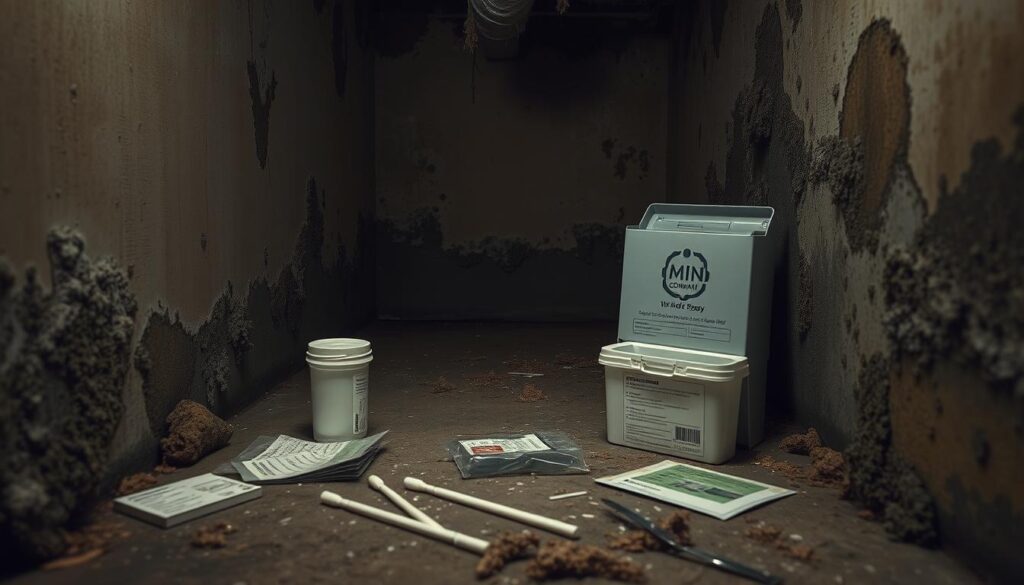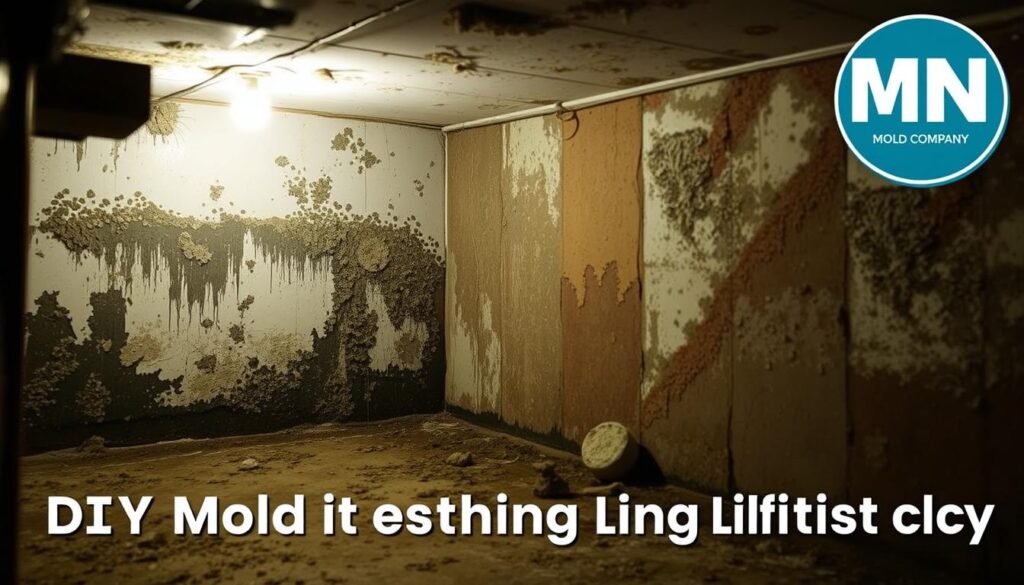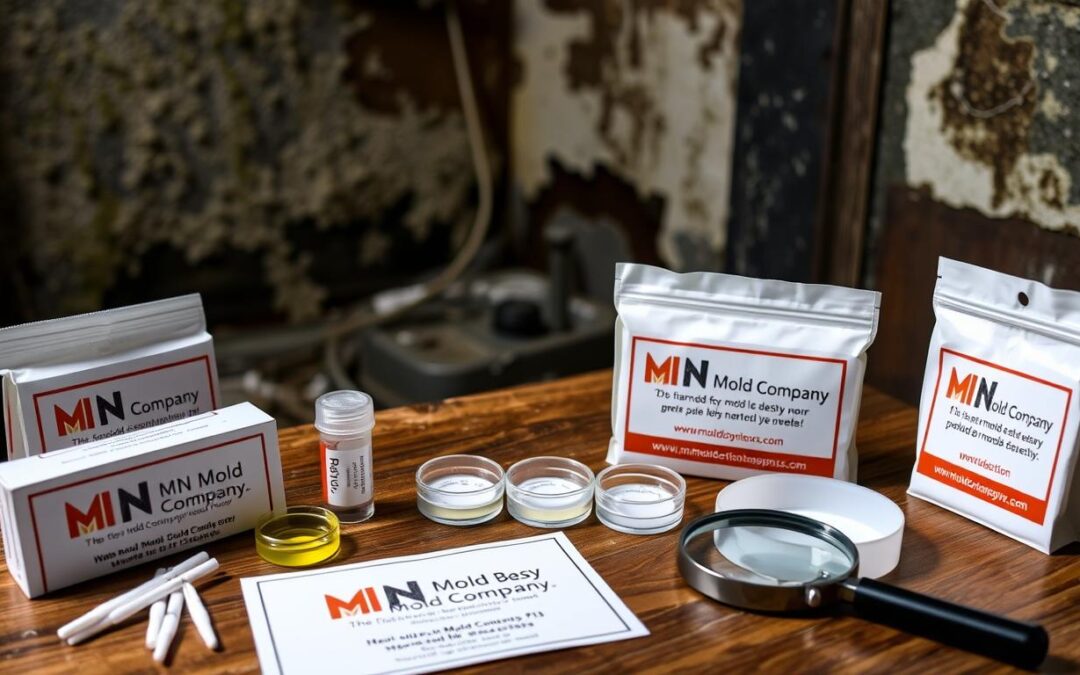Many homeowners are now using DIY mold test kits to check for mold in their homes. But are these kits really effective? Or do they often fail to give accurate results? This article explores the good and bad sides of DIY mold test kits. It aims to help you decide if they are the right choice for your home and family’s health.
Key Takeaways
- DIY mold test kits are easy to use and can save money, but their results are often not reliable.
- These kits don’t offer the detailed testing and expert advice that professional services do.
- DIY kits can give wrong results due to poor lab work, faulty equipment, and bad sampling materials.
- Experts and reviews warn against relying only on DIY kits. They say professional help is needed.
- For a safe and healthy home, you need a detailed, professional mold testing and cleanup plan.
Understanding the Limitations of DIY Mold Test Kits
DIY mold test kits might seem like an easy fix for mold worries at home. But, they have big problems that make them not very reliable. The main issue is they don’t do a full visual check, which is key for finding mold.
No Visual Inspection
DIY kits can’t find mold in secret spots. A good look around is needed to find mold and fix it right.
No Recommendations for Corrective Action
DIY kits also don’t tell you how to fix the mold problem. Even if they say mold is there, you won’t know how to deal with it. Experts can find the mold and tell you how to stop it from coming back.
DIY kits aren’t the best choice for finding mold at home. They might be cheap and easy, but they can’t give you the full picture or the right fixes you need.
“Without a visual inspection and tailored recommendations, DIY mold tests leave homeowners in the dark about the true extent of their mold problem and how to properly resolve it.”
Unreliable DIY Mold Testing Kit Lab Results
DIY mold test kits often fall short in providing reliable results. They use passive sampling methods like agar plates. These methods can’t give accurate counts of mold spores. This makes the lab analysis of these samples usually wrong and not consistent.
Another big problem is that the labs doing the analysis are not always certified. They might not follow the right steps to keep the samples safe. This can lead to results that are not trustworthy. Homeowners might end up making decisions based on bad information.
| Issue | Impact |
|---|---|
| Passive sampling methods | Inability to quantify mold spore concentrations |
| Uncertified lab analysis | Inaccurate and inconsistent test results |
| Lack of chain of custody protocols | Potential for contamination and unreliable findings |
The reliability of DIY mold test kit results is a big worry. Homeowners might make important decisions based on wrong data. It’s key to know the limits of DIY mold testing to handle mold problems wisely.
Uncalibrated Sampling Pumps Lead to Inaccuracies
Mold testing needs accurate results. But, many DIY kits have sampling pumps that are often cheap and wrong. These pumps make test results unreliable.
Importance of Calibration for Accurate Results
Professional mold testing uses calibrated pumps. These pumps are checked before and after each test. This ensures the data is correct.
Uncalibrated pumps can give wrong mold levels. This might make homeowners think the problem is smaller than it is. But, professional testing with calibrated pumps gives true air quality results. This helps fix the mold problem right.
“Proper mold testing requires the use of calibrated sampling pumps, a process that professional inspectors undertake before and after each sample collection to ensure the accuracy of the data.”
Calibrated sampling pumps are key for mold testing. Homeowners can trust the mold assessment with professional help and the right tools. This leads to the right steps to fix the mold.
Industry Experts Advise Against DIY Mold Testing Kits
Many homeowners might think about using DIY mold testing kits. But, top industry groups warn against this. The American Industrial Hygiene Association (AIHA) and the American Conference of Government Industrial Hygienists (ACGIH) say these kits are not a good idea.
DIY kits have big limitations. Experts say they can’t match the skills needed to find and measure mold. Homeowners need special training to collect and read samples right.
“Mold testing is a complex process that should be handled by trained professionals. DIY kits simply cannot provide the same level of accuracy and reliability as a comprehensive assessment conducted by an experienced industrial hygienist or mold remediation specialist.”
AIHA and ACGIH also stress the need for a detailed look and thorough tests. DIY kits can’t do this. They don’t have the right tools or know-how to check the mold fully.
In short, experts strongly advise against DIY mold testing kits. The dangers of wrong results and missing key mold issues are too great. For your family’s health, it’s best to get help from mold testing and removal pros.
DIY Mold Test Kits, are they worth it?
Using DIY mold test kits might seem like a good idea to find mold in your home. But, looking closer, these kits are not the best choice for keeping your air clean. They don’t offer much value for homeowners worried about their indoor air.
DIY kits can’t do a full visual check. Mold shows up in many ways, and a pro’s eye is needed to spot it right. These kits just can’t match the skill and care of a real inspection.
Also, the results from DIY kits are not always trustworthy. Without the right tools, the readings might not show the real mold levels. This can mean wrong fixes and wasted time.
| Pros of DIY Mold Test Kits | Cons of DIY Mold Test Kits |
|---|---|
| Convenient and accessible | Lack of visual inspection |
| Relatively low cost | Unreliable lab results |
| Provide a starting point for investigation | Uncalibrated sampling equipment |
| No recommendations for corrective action |
In the end, DIY kits have more downsides than upsides. It’s smarter to get a pro to check for mold. They give a full report, accurate tests, and the right fix. It might cost more upfront, but it’s safer and more effective in the long run.
“Mold can be a serious issue, and DIY kits simply don’t have the necessary expertise or equipment to accurately identify and address the problem. Homeowners are better off relying on professional mold testing services.”
Problematic Sampling Media in DIY Kits
DIY mold test kits often use sampling media that can lead to wrong results. Agar plates and spore traps are common issues. They can give false readings about mold in a home.
Agar Plates: A Recipe for Contamination
Agar plates are used in many DIY kits. But, they can easily get contaminated outside a lab. This can happen due to bad handling or exposure to the environment.
Such contamination can make the test results wrong. Homeowners might think they have more mold than they really do.
Spore Traps: Sensitive to Environmental Conditions
Spore traps are another issue in DIY kits. They’re meant to catch mold spores in the air. But, they’re very sensitive to temperature and humidity changes.
These changes can make the spore traps capture the wrong amount of mold. This can lead to false positives or negatives.
The problems with DIY mold kits can give homeowners wrong information. They might spend too much time and money on fixing something that’s not there. Or, they might miss a real mold problem because of the wrong data.

Consumer Reports Rates DIY Mold Tests as “Not Recommended”
Consumer Reports has a clear view on DIY mold test kits. They have tested these kits and found them lacking. They say these kits are not good for homeowners who want to find and fix mold problems.
Consumer Reports has several concerns with DIY mold test kits. They often leak, can get contaminated, and can’t accurately find mold spores. These problems make DIY tests unreliable for homeowners. They don’t give the right info about mold in a home.
Consumer Reports suggests that homeowners should use professional mold inspectors instead. These experts have the right tools and knowledge. They can really check for mold and tell homeowners how to fix it.
“DIY mold test kits are not a reliable way to identify and address mold issues in your home,” states the Consumer Reports review. “Homeowners are better off seeking the guidance of professional mold inspectors who can provide accurate, comprehensive assessments and recommendations.”
Consumer Reports is clear: DIY mold test kits are not a good choice. They might seem easy and cheap, but they’re not worth the risk. The chance of getting wrong results is too high. This shows why professional mold testing and fixing is the best option.
Hidden Costs and Lack of Comprehensive Testing
DIY mold test kits might seem like a simple fix, but they come with hidden costs. Homeowners often find out they need extra supplies like special containers or pumps. This can make the total cost much higher.
Also, DIY mold testing kits don’t give a full picture of mold problems. They don’t include a detailed visual check, which is key to finding the source and size of the issue. Without this, homeowners might not get the full story and can’t fix the problem right.
- DIY mold test kits often come with hidden costs for additional sampling supplies
- These kits do not provide a comprehensive assessment, as they lack a visual inspection of the affected area
- Addressing mold issues requires a holistic approach that DIY kits simply cannot deliver
Fixing mold issues needs a detailed and expert plan. DIY kits might look cheap and easy, but they have big downsides. They can cause more problems and cost more over time. So, the hidden costs and lack of comprehensive testing make DIY kits not the best choice for tackling mold problems.
| Feature | DIY Mold Test Kits | Professional Mold Testing |
|---|---|---|
| Visual Inspection | No | Yes |
| Sampling Accuracy | Limited | Highly Accurate |
| Corrective Action Recommendations | No | Yes |
| Comprehensive Testing | No | Yes |

Reliable Mold Testing Requires Professional Expertise
Getting mold problems right in your home needs experts. The U.S. Environmental Protection Agency (EPA) says it’s best to have professionals. They know how to find and fix mold issues.
Professional mold testing means a full check-up. This includes looking around, taking samples, and analyzing them. It helps figure out the best way to fix the problem.
EPA Recommendations for Professional Mold Testing
The EPA tells homeowners to get a pro for mold testing. They say it’s key for several reasons:
- Experts do a thorough look to see where mold is and how much there is.
- They use special tools to collect air and surface samples.
- Lab tests by experts show what kind of mold and how much.
- They give a detailed report on what they found and how to fix it.
Trying to test for mold yourself can be a bad idea. You might not get the right results. This makes fixing the mold harder.
| Benefits of Hiring a Professional Mold Inspector | Drawbacks of DIY Mold Testing |
|---|---|
|
|
The EPA stresses the need for professional mold testing. Without it, homeowners might not get the full picture. This can lead to bigger and more expensive problems later.
Conclusion
DIY mold test kits are not a good choice for homeowners worried about indoor air quality. These kits can’t provide a full picture of mold problems. They often give unreliable results and can be expensive.
It’s better to hire experts like mold inspectors and industrial hygienists. They can do a detailed check and find the right way to fix mold issues. These professionals have the right tools and knowledge to get accurate results.
Choosing DIY kits can lead to problems because they lack professional expertise. They also need special equipment to work right. Working with experts ensures mold problems are fixed correctly, keeping homes safe and healthy.
FAQ
Are DIY mold test kits effective?
DIY mold test kits have big problems. They miss the key step of a visual check. They also give bad lab results and use wrong sampling tools. This makes them not good for finding and fixing mold issues.
What are the pros and cons of using DIY mold test kits?
DIY kits are easy to use and cheap. But, they have big downsides. They miss the visual check, give bad lab results, and use wrong tools. This means they often give wrong and useless results.
Should I use a DIY mold test kit or hire a professional mold inspector?
It’s best to hire a pro mold inspector. DIY kits are not reliable or effective. A pro will do a full check and know how to fix mold problems.
How accurate are DIY mold test kits compared to professional mold testing services?
DIY kits are not as good as pro services. Their lab results are often wrong because of bad sampling and tools. Pro services give accurate results and understand mold problems well.
What is the cost of DIY mold test kits compared to hiring a professional?
DIY kits are cheaper at first. But, they might cost more in the long run if they don’t find the mold right. Pro services cost more upfront but give a full check and fix mold problems well.
What are the best DIY mold test kits for home use?
Many DIY kits are out there, but experts don’t recommend them. They miss important steps, give wrong results, and use bad tools. This makes them a bad choice for finding mold.
When should I choose DIY mold testing over professional mold testing services?
Don’t choose DIY kits often. They don’t have the skills or tools needed for a good mold check. It’s better to get a pro who can do a full check and fix mold problems.
Can I use a DIY mold test kit to check my home’s air quality?
DIY kits say they check air quality, but they’re not reliable. Real air quality testing needs special tools and a pro to understand the results. It’s safer to get a pro for a full air quality check.
How do I use a DIY mold test kit?
Using a DIY kit means collecting a sample and sending it to a lab. But, these kits are not trusted for finding mold. They miss important steps and don’t give reliable results.
Source Links
- 7 Reasons Mold Testing Kits are a Scam — Viva Environmental, Health, & Safety (EHS)-Mold, Asbestos, Lead, Industrial Hygiene, Silica, Sampling, HASPs, Phase I ESA.
- 10 Reasons Why Do-It-Yourself (DIY) Mold Test Kits Are Not Accurate or Advised | Indoor Doctor
- Mold Test Kits – A Waste of Money – Air Quality Consultants

